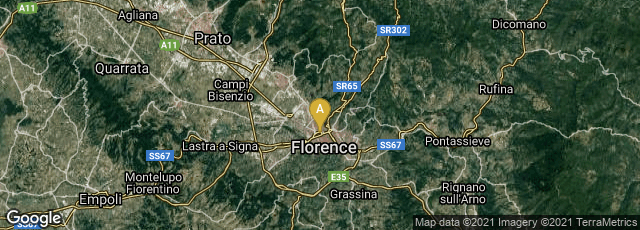

Having begun his career as a cartolaio, a stationer or dealer in paper and parchment, Vespasiano da Bisticci became the leading bookseller in Italy during the decades immediately before the invention of printing, and during the first years of its introduction in Italy. He retired in 1480 supposedly disappointed by the changes in the book trade brought about by printing.
By the 1440s Vespasiano owned a bookshop in Florence patronized by members of Florence's humanist community, through whom he was in contact with local scribes, illuminators and binders. Though he was not particularly well educated and had only a modest knowledge of Latin, he was a very shrewd businessman, and he left valuable memoirs informing us of some of his achievements. These were first published in print as Vite di uomini illustri del secolo xv by Ludovico Frati (Bologna, 1892-93); they were translated by William George and Emily Waters as The Vespasiano Memoirs: Lives of illustrious Men of the XVth century by Vespasiano da Bisticci, Bookseller (1926).
When Federico de Montefelto, Duke of Urbino set about building a library he hired Vespasiano to supply all of its books. Vespasiano's description of its contents is especially interesting for its recitation of the authors and works that the Duke and his advisors felt should be included in his library. As one would expect, after more than five hundred years, some of these remain familiar to scholars; others, of course, have become more or less obscure. I was less familiar with the Renaissance names than the names from antiquity or early Christianity. Out of curiosity I looked up most of the names that were obscure to me in November 2014, and linked to them when a reference was available.
Another element of Vespasiano's comments, written toward the end the quotation below, is his reference to the catalogues of the library of the Pope (then at the Lateran Palace before it was established in 1451 at the Vatican), the library of San Marco (Florence), and those at Pavia and Oxford, which he had obtained in manuscript for comparison with the Urbino library. This is the earliest reference that I recall reading where the holdings of different libraries were compared. It is significant, I think that Vespasiano was aware of, and could obtain the catalogue of the library at Oxford in addition to major libraries in Italy. One wonders whether he was also aware of the much larger library at the University of Paris, and if he could have obtained a catalogue of the holdings there.
The process of creating and collecting Federico's library took fourteen years, especially since Federico resolved
"to do what no-one had done for a thousand years or more; that is to create the finest library since ancient times. He spared neither cost nor labour, and when he knew of a fine book, whether in Italy or not, he would send for it. It is now fourteen or more years since he began the library, and he always employed, in Urbino, in Florence and in other places, thirty or forty scribes in his service. He took the only way to make a fine library like this: by beginning with the Latin poets, with any comments on the same which might seem merited; next the orators, with the works of Tully [Cicero] and all Latin writers and grammarians of merit. . . . He sought also all the known works on history in Latin, and not only those, but likewise the histories of Greek writers done into Latin, and the orators as well. The Duke also desired to have every work on moral and natural philosophy in Latin, or in Latin translations from Greek.
"As to the sacred Doctors in Latin, he had the works of all four. . . .After the four Doctors, he was set on having the works of S. Bernard and of all the Doctors of old, without exception, Tertullian, Hilarius, Remigius, Hugh de S. Victor, Isidore, Anselm, Rabanus and all the rest. After Latin works came Greek writings done into Latin, Dionysius the Areopagite, Basil, Cyril, Gregory Nazianzen, John of Damascus, John Chrysostom, Gregory of Nicea, all the works of Eusebius, of Ephreme the monk, and of Origen. . . . Coming to the Latin Doctors in philosophy and theology, all the works of Thomas Aquinas, and of Albertus Magnus; of Alexander ab Alexandro, of Scotus, of Bonaventura, of Richard of Mediavilla [Richard of Middleton], of the Archbishop of Antoninus and of all the recognised modern Doctors, down to the Conformità of S. Francis; all the works on civil law in the finest text, the lectures of Bartolo written on goat-skin. He had an edition of the Bible made in two most beautiful volumes, illustrated in the finest possible manner and bound in gold brocade with rich silver fittings. It was given this rich form as the chief of all writings. With it are all the commentaries of the Master of the Sentences, of Nicolao di Lira, and of all the Greek and Latin Doctors, together with the literal glossary of Nicolao di Lira. Likewise all the writers on astrology, geometry, arithmetic, architecture and De re Militari; books on painting sculpture, music and canon law, and all of the texts and lectures on the Summa of Ostiensis and other works in the same faculty. In medicine all lthe works of Avicenna, Hippocrates, Galen, the Continenti of Almansor and the complete volume of all the Councils, held since ancient times, and the logical, philosophical and muscial works of Boethius.
"There were all lthe works of modern writers beginning with Pope Pius; of Petrarch and Dante in Latin and in the vulgar tongue, of Boccaccio in Latin; of Coluccio and of Lionardo d'Arezzo, original and translations; of Fra Ambroglio, of Giannozzo Manetti and Guerino; the prose and poetical works of Panormita, and Francesco Filelfo, and Compano; as well as everything written by Perrotto, Maffeo Vegio, Nicolo Secondino (who was interpreter of Greek and Latin at the Council of the Greeks in Florence), Pontano, Bartholomeo Fazi, Gasparino, Petro Paolo Vergerio, Giovanni Argiropolo (which includes the Philosophy and Logic of Aristotle and the Politics besides), Francesco Barbaro, Lionardo Giustiniano, Donato Acciaiuoli, Alamanno, Rinuccini, Cristofano da Prato, Vecchio, Poggio, Giovanni Tortello, Francesco d'Arezzo and Lorenzo Valla.
"He added to the books written by ancient and modern doctors on all the faculties all the books known in Greek, also the complete works of Aristotle and Plato (written on the finest goat-skin); of Homer in one volume, the Ilia, the Odyssey, and the Batrachomiomachia; of Sophocles, Pindar and Menander, and all the other Greek poets; a fine volume of Plutarch's lives and his moral works, the Cosmography of Ptolemy illustrated in Greek, and the writings of Herodotus, Pausanius, Thucydides, Polybius, Demosthenes, Aeschines and Plotinus. All the Greek comments, such as those upon Aristotle, the Physica de Plantis and Theophrastus; all the Greek vocabulists—Greek into Latin; the works of Hippocrates, Galen, Xenophon, S. Basil, S. John Chrystotom, S.Athanasius, S. John Damascenas, S. Gregory Nazianzen, S. Gregory of Nicea, Origen, Dionysius the Areopagite, John Climacus, S. Ephrem the monk, Aeneas the Sophist, the Collations of John Cassanus, the book of Paradis, Vitae sanctorum patrum ex Aegypto, the Life of Barlaam and Josephat, a wonderful psalter in Hebrew, Greek and Latin, verse by verse, and all the Greek works on geometry, arithmetic, and astrology. Finding that he lacked a vast number of Greek books by various writers, he sent to seek them so that nothing in that tongue which could be found should be lacking; also whatever books were to be had in Hebrew, beginning with the Bible and all those dealt with by the Rabbi Moses and other commentators. And besides the Holy Scriptures, there are books in Hebrew on medicine, philosophy and the other faculties.
"The Duke, having completed this noble work at the cost of thirty thousand ducats, beside the many other excellent provisions that he made, determined to give every writer a worthy finish by binding his work in scarlet and silver. Beginning with the Bible, as the chief, he had it covered iwth gold brocade, and then he bound in scarlet and silver the Greek and Latin doctors and philosophers, the histories, the books on medicine and the modern doctors, a rich and magnificent sight. In this library all the books are superlatively good, and written with the pen, and had there been one printed volume it would have been ashamed in such company [emphasis mine]. They were beautifully illuminated and written on parchment. This library is remarkable amongst all others in that, taking the works of all writers, sacred and profane, original and translated, there will be found not a single imperfect folio. No other library can show the like, for in all of them the works of certain authors will be wanting in places. A short time before the Duke went to Ferrara it chanced that I was in Urbino with His Lordship, and I had with me the catalogues of the principal Italian libraries: of the papal library, of those of S. Marco at Florence, of Pavia, and even of that of the University of Oxford, which I had procured from England. On comparing them with that of the Duke I remarked how they all failed in one respect; to wit, they possessed the same work in many examples, but lacked the other writings of the author; nor had they writers in all the faculties like this library" (George & Waters, 102-105).
Vespasiano was responsible for supplying over half of the thousand volumes in the library of the Duke of Urbino. He also performed the same service for Cosimo de' Medici. For that project Vespasiano engaged fifty-five scribes and illuminators who completed two hundred superb manuscripts in under two years.